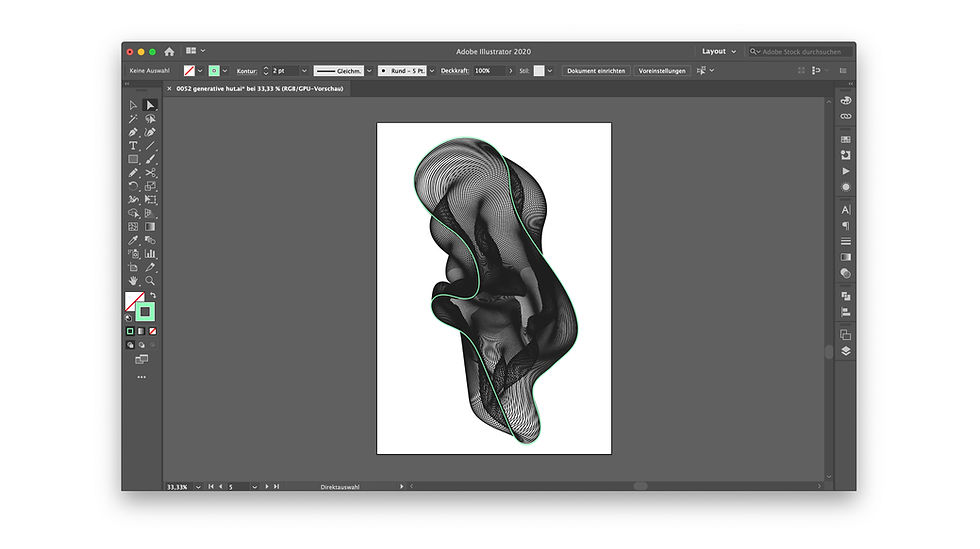Create generative art without coding
- Anna Stumpf

- Dec 12, 2020
- 2 min read
Updated: Jun 12, 2021
You don’t need to be a coder to create generative art. There are different ways to create computer-generated patterns in a visual way. In this tutorial, I show you one way of doing this.
I start with creating a shape in Illustrator. For this, I use the pencil tool (N). In my opinion, drawing by hand has a kind of random factor that can help to create a special organic shape. After that, I use the pen tool (P) to make some adjustments on the shape.
You can double click on the pencil tool (N) icon to specify in the settings, how Illustrator should smooth the line you draw.

After drawing the shape in Illustrator, I copy and paste it to Sketch. Sures Kumar created the awesome Looper Sketch plugin that I use for the next step. In the settings of the plugin I choose the following values:
→ Number of copies: 100
→ Scale: X and Y, -4 px
→ Move: horizontally, 1 px
→ Rotate: sinusoidal, sin factor 4
After creating the pattern, I copy and paste it in Illustrator. Until now the shape looks like a “half nut”, but I want it to look like a “completed nut”. 🥜

That’s why I go back to Sketch and create another pattern with the Looper plugin. I use the same initial shape as for the first pattern. But the second pattern should align itself in a different direction. For this I choose the following values:
→ Number of copies: 100
→ Scale: X and Y, -4 px
→ Move: horizontally, 3 px
→ Rotate: sinusoidal, sin factor 3
I copy the shape and paste it again in Illustrator. Although both patterns are different, they still have the same initial shape. These both lines should lie on top of each other (marked green in the following screenshot). I delete one of the lines because I don't want the pen plotter to draw it twice.

After that, I open the file in Inkscape. Fortunately, it’s possible to just open the Illustrator file in here without converting it.

Now Axidraw can draw the pattern. For this tutorial, I created a black and a white version.
This is how the two final results look like:

My name is Anna Stumpf and I’m a designer living in Germany. I founded the project experiment now! when I felt that my full-time design job wasn’t training my creativity enough. This project offers me the freedom to create things with my hands without having to think about it before. I am in search of the random factor, which emerges between analog ↔ digital and currently experimenting with the pen plotter Axidraw. 🤖






This tutorial is cool! I'm always looking for easy ways to make art without coding. This is way different than anything to do with Free Steal a Brainrot Calculator for Roblox, but could still be a fun distraction.
Create professional bills quickly with invoice. Manage clients, track payments, and simplify your business today.
I’ve used a lot of tools, but this gradient generator truly nails simplicity and function. Ideal for both CSS newbies and pros.
Love this article! If you like lighthearted games with a chaotic twist, Ragdoll Hit is worth checking out. Merge Rot and Bubble Shooter are my current favorites for some quick fun.
qiuqiu99
qiuqiu99
qiuqiu99
qiuqiu99
qiuqiu99
qiuqiu99
qiuqiu99
qiuqiu99
qiuqiu99
qiuqiu99
qiuqiu99
qiuqiu99
qiuqiu99 qiuqiu99
qiuqiu99 qiuqiu99 qiuqiu99
qiuqiu99
qiuqiu99
qiuqiu99
qiuqiu99
qiuqiu99
qiuqiu99
qiuqiu99
qiuqiu99
qiuqiu99
qiuqiu99
qiuqiu99
qiuqiu99
qiuqiu99
qiuqiu99
qiuqiu99
qiuqiu99
qiuqiu99
qiuqiu99
qiuqiu99
qiuqiu99
qiuqiu99
qiuqiu99